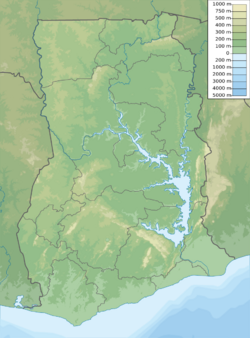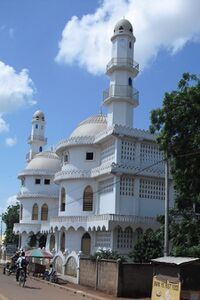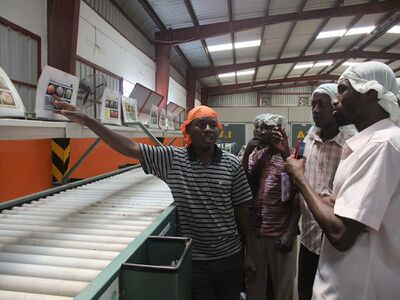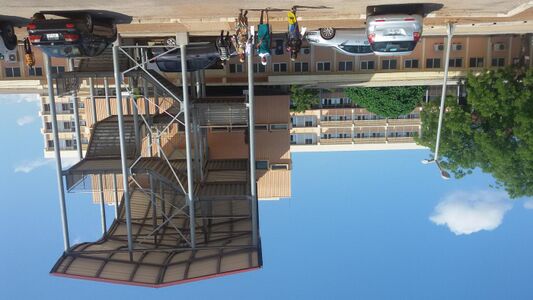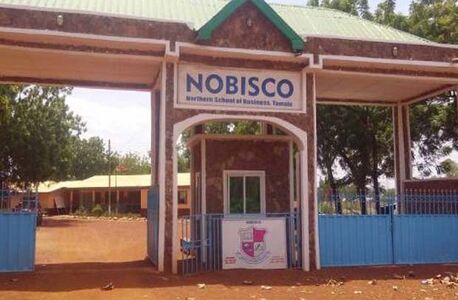Tamale, Ghana
Topic: Place
 From HandWiki - Reading time: 9 min
From HandWiki - Reading time: 9 min
Tamale | |
|---|---|
Major city | |
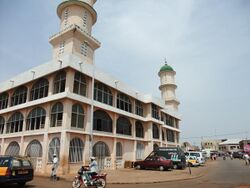 Road in Tamale, Northern Region. | |
| Coordinates: [ ⚑ ] : 09°24′27″N 00°51′12″W / 9.4075°N 0.85333°W | |
| Country | |
| Region | Northern Region |
| District | Tamale Metropolitan District |
| Government | |
| • Type | Mayor-Council |
| • Mayor | Sule Salifu |
| Area | |
| • Total | 750 km2 (289.58 sq mi) |
| Elevation | 151 m (495 ft) |
| Population (2010) | |
| • Total | 950,124 |
| • Density | 480.77/km2 (1,245.18/sq mi) |
| Time zone | UTC |
| Postal codes | NT0000 - NT2701 |
| Area code(s) | 037 |
| Website | tamalemetro.gov.gh |
Tamale (dag) is the capital city of the Northern Region of Ghana.[2] It is Ghana's third largest city, with a population of 950,000.[3] The city has been ranked as the fastest-growing city in West Africa.[2][4] It is located 600 km (370 mi) north of Accra.[5]
Tamale is located in the Kingdom of Dagbon, Ghana's oldest Kingdom. Traditional authority are subservient to the King of Dagbon, the Ndan Yaa Naa, who is resident at Yendi (Yani). Yendi is the traditional capital and seat of Governance of the king. The language of the people in Tamale is Dagbani.[6]
Tamale sits at a strategic location due to its greater proximity European, West African, and North African markets compared to Ghana's southern cities . It serves as a political, economic and financial center of the Northern Ghana.The city connects the coastal and forest area of Ghana to West and North Africa. The city's central business district hosts regional branches of financial institutions and a considerable number of international and local non governmental organisations.[7]
The hospitality industry has grown significantly, with increasing investment in infrastracture.[8][9] Tamale grew from a conglomeration of towns with an architectural blend of traditional mud houses and modern buildings. Tamale's new and modern facilities include the newly constructed Tamale Stadium (now Aliu Mahama sports Stadium named after late Ghana's vice-president, Alhaji Aliu Mahama), replacing the town's former principal football pitch, Kaladan Park. Improvements to Tamale's infrastructure occurred in the period leading up to the 2008 African Cup of Nations.[9] The Tamale sports stadium was renamed after the late Vice president, Alhaji Aliu Mahama in the year 2018. Motorcycles are a common form of transportation.
More than 80% of residents are Dagombas, and 90.5% are Muslims.[10] This is reflected by the multitude of mosques in Tamale, most notably the Tamale Central Mosque, Afa Ajura Mosque (Anbariya Mosque), Afa Basha mosque (Nuuria mosque) and The Ahmadiyyah Muslim mission Mosque.
History
Tamale is located on the crossing of three ancient trade routes; it started to grow as a commercial centre for the Northern region centuries ago. The north–south road from Paga and Bolgatanga to Salaga had raiders passing, whilst other merchants brought their goods into Tamale. Salt came from Daboya, to the north-west of Tamale, and followed a road that continued to Yendi. A third road linked Gushegu to the capital and continued to the Gonja kingdom, Damongo. The present locations of the central market and the palace of the Gulkpe naa,[11] opposite Barclays Bank and near the library, mark the junctions of the ancient roads.
Around this palace, a residential neighbourhood began to grow. It is now known as Dagbangdabi-Fong (the name means "Traditional men area"). This was followed by Changli, Belipiela, and BuglanaFong ("Fetish Priest's area") further to the south. Each neighbourhood got its own local chief. As the distances to the market place grew, people started to settle elsewhere around the crossing, so the quarters of Tishigu and Abu-Abu came up. An influx of northerners from present-day Burkina Faso led to the building of Moshi Zongo. In the same time, the remote village of Vitteng came into existence.
Garden cities were brought to Tamale and at the back of Sakasaka grew Kalpohin Estates, even now a pleasant neighbourhood with plenty trees, big gardens, and small houses. In the 1970s, urban extensions such as Zogbeli, Lamakara, and Lamashegu were built, neighbourhoods characterised by checkboard planning of square house plots and orthogonal streets and alleys. Since 2000, Tamale seems to have grown more rapidly, so the whole district of Tamale is now urban agglomeration.
Climate
Tamale features a tropical wet and dry climate under the Köppen's climate classification. The metropolis experiences one rainy season from April to September or October, with a peak in September and August. The mean annual rainfall is 1100 mm within 95 days of rainfall in the form of tropical showers. Consequently, staple crop farming is highly restricted by the short rainy season.[12]
The dry season is usually from November to early April. It is influenced by the dry north-easterly (Harmattan) winds, while the rainy season is influenced by the moist south-westerly winds. The mean daytime temperatures range from 28 (December and mid-April) to 43 (March, early April) degrees Celsius, while mean nighttime temperatures range from 18 (December) to 25 (February, March) degrees Celsius. The mean annual daily sunshine is about 7.5 hours.
Script error: No such module "weather box".
Government
Tamale has a mayor–council government system in which the mayor is vested with extensive executive powers. The mayor is appointed by the Ghana president and approved by the town council, the Tamale Metropolitan Assembly, although suggestions have been made by the residents of Tamale to increase accountability of the office by having the mayor elected. The current mayor of Tamale is Hon. Sule Salifu.[14] The name Tamale Metropolitan Assembly serves both for the local parliament and for the local executive. Local policies are always executed in this name, so for example, illegal constructions often show the command "remove by TMA" (meaning that the Tamale Metropolitan Assembly or its executive has ordered to remove the building as it is contrary to current urban land-use planning). As the local executive, Tamale Metropolitan Assembly is the strong arm of the mayor, his or her civil service. If mention is made of assembly women or men, however, the reference is to the elected representatives of the inhabitants of Tamale. They form the assembly properly speaking, and must decide about local by-laws before they can come into force. The name "Tamale Metropolitan District" is used in the geographical sense, to refer to the area within its borders.
Education
Tamale is the principal centre of education in Northern Ghana. Currently, a total of 742 basic schools are within the metropolis. This comprises 94 kindergartens, 304 primary, 112 junior high, and 14 senior high schools. The rest are technical/vocational institutions, two colleges of education, a technical university and two other universities – one public and the other private.[8]
In the Education Ridge neighbourhood in the north-western part of the town and covering an area around 3 km2, 20 schools ranging from kindergartens through junior high and senior high schools, teachers' training colleges, the Tamale Technical University, and a university are located. The numerous trees lining the streets in this part of the town give it a tropical rainforest outlook. The University for Development Studies (UDS) has two campuses located in Tamale and one in nearby Nyankpala. The headquarters of the UDS is also located in Tamale.[15]
- Primary schools
- Munawara Ahmadiya E/A Primary School
- OLA Primary School
- Koblimahigu Sobriya E/A Primary School
- Kukuo AME Zion Primary School, Wurishe Kukuo
- Ansuari-Deen Islamic Primary School
- Anbariya Ibnitaimiya English/Arabic Primary School
- Amriya Islamic Primary School, Kakpagyili
- Aminiyat Islamic Primary School, Sawaba
- Amania Islamic Primary/Kg School
- Al-Markazia Islamic Junior High School, Zogbeli
- Al -Mal Islamic Basic Schools, Tamale
- Al-Egasa Islamic Primary School, Kasaligu
- Adubliyili Preby Primary School
- Adabiya Garibiy Islamic Kg/Primary School, Tamale
- Abubakar Sadoq Islamic Primary School, Vittin
- Aalu Ibrahim Islamic Primary School
- Junior high schools
- Munawara Ahmadiya E/A Junior High School
- Wurishe Kukuo Junior High School
- Koblimahigu Sobriya E/A
- Nahada Islamic Junior High School
- Badariya Islamic Junior High School
- Senior high schools
- Tamale Senior High School
- Ghana Senior High School
- Northern School of Business
- Business Senior High School
- Tamale Girls Senior High School
- Viting Senior High School
- Kalpohin Senior High School
- Tamale Islamic Science Senior High School
- St Charles Minor Seminar Senior High School
- Adventist Senior High School
- Presbyterian Senior High School
- Business College International
- Tamale Girls International School
- Ambariya Senior High School
- Dabokpa Technical and Vocational School
- T- Poly Senior High School
- Abubakar Al-sadiq Senior High School
- Ideal College
- Kasuliyili Senior High school
- Colleges and Universities
- Bagabaga College of Education
- Tamale College of Education
- Jackson College of Education
- University for Development Studies
- Tamale Technical University
- Technical University College of Tamale
- Driving Schools
- Johnson Driving School
- Abele Driving School
Transportation
Tamale is served by Tamale Airport. Located about 11 km (6 nmi; 7 mi) from downtown Tamale, the airport is mainly used by commercial airlines such as Africa World Airlines and Passion Air which are the only operational companies currently. They run regular flights between Tamale and Accra's Kotoka International Airport, along with other regional capitals.[16]
There are Public Transports from Tamale to major citie such as Kumasi; Accra, Mim, Ahafo ; Cape Coast, Sunyani; Takoradi; Tema; Ho; Wa; Bolgatanga; Elubo; Aflao, Techiman; Public transportation in the form of taxis used to be the most convenient means of getting around Tamale for visitors to the town until the arrival of the Tri-cycles, popularly called "Mahama-Cambuu" or yellow-yellow. Mahama Cambuu is a coined name by the local people from the expression "Mahama can do". This is because these Tri-cycles (mostly yellow in color) came in the era of the former president, H.E John Dramani Mahama. It is comparatively cheaper than the Taxis and usually on the move unlike the Taxis that are regularized and stationed at a points. It is however, not very safe compared to the Taxis. The popular means of travel for the locals, however, is by motorbike. This phenomenon is helped by the existence of bike paths in the town, making it one of the most bike-friendly settlements in the Northern region. Transportation out of town is facilitated by the Tamale's bus rapid transit system, tro-tro private mini-bus system, MetroMass Bus-Based Mass Transit system, and STC Bus Lines, along with a host of charter bus companies, all of which provide transport to connect Tamale with the many other surrounding towns and cities.
Gallery
Sister cities
Tamale has sister city relations with:
| City | Country | Date | Reference |
|---|---|---|---|
| United States | 1979 | [17] | |
| Burkina Faso | 2003 | [18] | |
| Niger | 2007 | [19] |
Key Landmarks
- Tamale Central Mosque
- Dakpema Chief's Palace
- Aliu Mahama Sports Stadium
- Tamale Jubilee Park
Notable people
- Mubarak Wakaso (born 1990), professional footballer
- Haruna Iddrisu (born 1970), Member of Parliament for Tamale South and the former Minister for Employment and Labour Relations in Ghana, Minority leader of Parliament[20]
- Abdul Majeed Waris (born 1991), professional footballer[21]
- Fancy Gadam (born 1988), Afro-pop and dancehall artiste[22]
- Alhassan Yahaya Seini, barrister and director of the Legal Aid Commission
- Mahamudu Bawumia (born 1963), politician
- Sheikh Bayan Basha
- Sheikh Saeed
- Chief Gupkenaa
- Chief Dakpema
- Alhassan Suhiyini (member of Parliament for Tamale-North constituency).
- Inusah Fuseini (a former member of Parliament for Tamale-Central constituency)[23]
- Alhassan Bashir Fuseini (member of Parliament for Sagnarigu constituency).
- Anyars Ibrahim (Ceo of Nation's builders corps).[24]
- Mona 4Reall, (born 1993) Socialite, model, musician, and businesswoman
- Maccasio (born April 6, 1995), Hip hop, hip life and an entrepreneur[25]
- Ibrahim Mahama (born 1987), artist[26]
Ongoing Projects
- The Tamale Interchange. Which is about 80% complete. It is hoped that the project will be fully completed by the end of 2021.[27][28]
- Tamale International Airport. Phase II is in progress.[29]
Communities in Tamale
- Lamashegu
- Zogbeli
- Kakpagyili
- Zujung
- Vitting
- Kukuo
- Kanvilli
- Gumani
- Jisonayili
- Gurugu
- Dungu
- Bamvim
- Bulpeila
- Sabonjida
- Sakasaka
- Tishigu
- malishegu
- Nyanshegu
- Kalpohini
- Dabokpa
- Choggu
- Kalariga
- Katariga
- Tuutingli
- Zagyuri
- Sagnarigu
- Yapalsi
- Sognayili
- Kpalsi
- Wurishe
- Changli
- Fuo
- Kunyevula
- Guunayili
- Aboabo
- Gumbihini
- Shishagu
- Kasaligu
- Nyerizee
- Datoyili
- Adubiliyili
- Manguli
- Sabonjida
Hotels and Guest Houses in Tamale
1. Picona Hotel
2. Radarch Lodge and Conference Centre
3. Miricha Hotel
4. Nim Avenue
5. Modern City Hotel
6. Sabonkudi estates
7. Regal hotel
8. Target Hills hotel
9. Pioneer lodge
10. B Sheini hotel
11. Naat guesthouse
12. Ganaa hotel
13. Global dream hotel
References
- ↑ "Location & Size". Ghanadistricts.com. http://ghanadistricts.com/districts/?r=6&_=80&rlv=location.
- ↑ 2.0 2.1 GhanaWeb.com ghanaweb.com
- ↑ "Tamale, Ghana Metro Area Population 1950-2023". https://www.macrotrends.net/cities/21110/tamale/population.
- ↑ "The largest cities in Ghana, ranked by population". Mongabay.com. 2013. http://population.mongabay.com/population/ghana.
- ↑ Tamale, Northern Region (Ghana). icli.nl.
- ↑ "Ghana City Tamale". https://www.ghanaweb.com/GhanaHomePage/geography/tamale.php.
- ↑ Tamale, capital of Northern region, Ghana. ghana-net.com.
- ↑ 8.0 8.1 Tamale Children's Home Tamale, Northern Region (Ghana). catointl.org
- ↑ 9.0 9.1 Tamale metropolitan
- ↑ "About TaMA – Tamale Metro Assembly" (in en-US). https://tamalemetro.gov.gh/about-tama/.
- ↑ The Gulkpe naa is one of the seven district chiefs in the Dagbon; in rank directly under the Paramount Chief, he overlooks the local chiefs in and around Tamale.
- ↑ "Advances in forecast verification". Weather 70 (1): 14–14. January 2015. doi:10.1002/wea.2445. ISSN 0043-1656. http://dx.doi.org/10.1002/wea.2445.
- ↑ "Klimatafel von Tamales / Ghana" (in de). Baseline climate means (1961-1990) from stations all over the world. Deutscher Wetterdienst. http://www.dwd.de/DWD/klima/beratung/ak/ak_654180_kt.pdf.
- ↑ "Sule Salifu confirmed as MCE for Tamale" (in en-US). 2021-09-30. https://citinewsroom.com/2021/09/sule-salifu-confirmed-as-mce-for-tamale/.
- ↑ Introduction to Tamale and the Northern Region. sclou.org.
- ↑ Tamale Airport Listings. Ghanapedia.
- ↑ Sister City International Listings – Directory Search Results – Tamale, Ghana . sister-cities.org.
- ↑ Tamale establishes links with sister city in Burkina-Faso. ghanaweb.com. 31 December 2003.
- ↑ TAMALE : Sister city relations should improve trade and investments . ndn.nigeriadailynews.com. 2 July 2007.
- ↑ "Hon. Iddrisu Haruna". Parliament of Ghana. http://www.parliament.gh/hon_iddrisu_haruna.html.
- ↑ "Abdul Majeed Waris" (in en). https://www.righttodream.com/abdul-majeed-waris.
- ↑ "Fancy Gadam". https://mobile.ghanaweb.com/GhanaHomePage/people/person.php?ID=2206.
- ↑ "'Nothing wrong with criticizing judges constructively' – Inusah Fuseini backs Ayine" (in en-US). 2021-06-10. https://citinewsroom.com/2021/06/nothing-wrong-with-criticizing-judges-constructively-inusah-fuseini-backs-ayine/.
- ↑ "Dr Ibrahim Anyars Archives - MyJoyOnline.com" (in en-US). https://www.myjoyonline.com/tag/dr-ibrahim-anyars/.
- ↑ "Rapper and Afrobeat star, Maccasio drops new single" (in en). 2017-02-20. https://www.ghanaweb.com/GhanaHomePage/entertainment/Rapper-and-Afrobeat-star-Maccasio-drops-new-single-Kaman-How-512037.
- ↑ "Ibrahim Mahama" (in de). http://www.documenta14.de/de/artists/13704/ibrahim-mahama.
- ↑ "Tamale Interchange to be completed by end of 2021 - Contractor - MyJoyOnline.com" (in en-US). https://www.myjoyonline.com/tamale-interchange-to-be-completed-by-end-of-2021-contractor/.
- ↑ mulyungi, patrick (2021-08-16). "Tamale Interchange construction in Ghana on the verge of completion" (in en-us). https://constructionreviewonline.com/news/tamale-interchange-construction-in-ghana-on-the-verge-of-completion/.
- ↑ "Ghana to start construction of phase II of Tamale Airport" (in en-us). 2019-08-16. https://constructionreviewonline.com/news/ghana/ghana-to-start-construction-of-phase-ii-of-tamale-airport/.
External links
| Wikivoyage has a travel guide for Tamale. |
- Official website of the Tamale Metropolitan Assembly
- Official Tamale Senior High Page
- Official UDS website
 |
 KSF
KSF